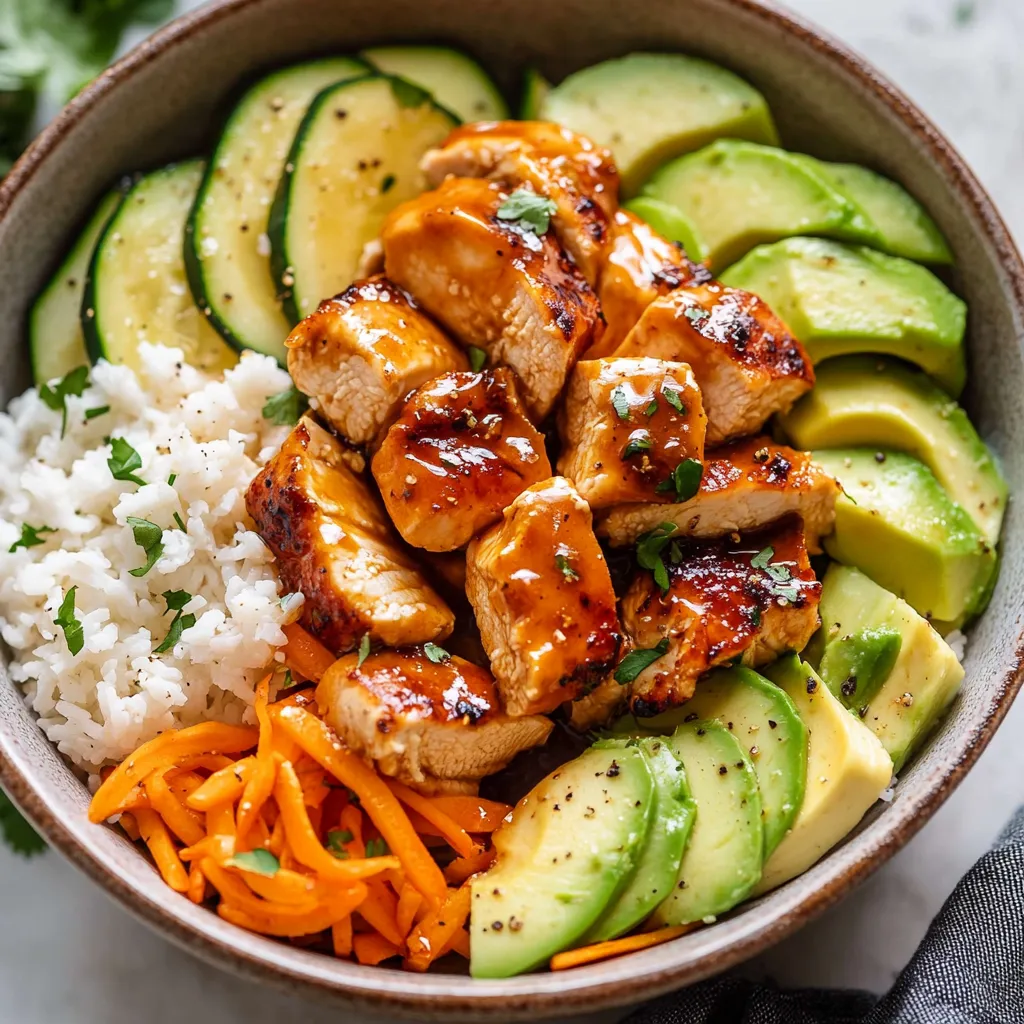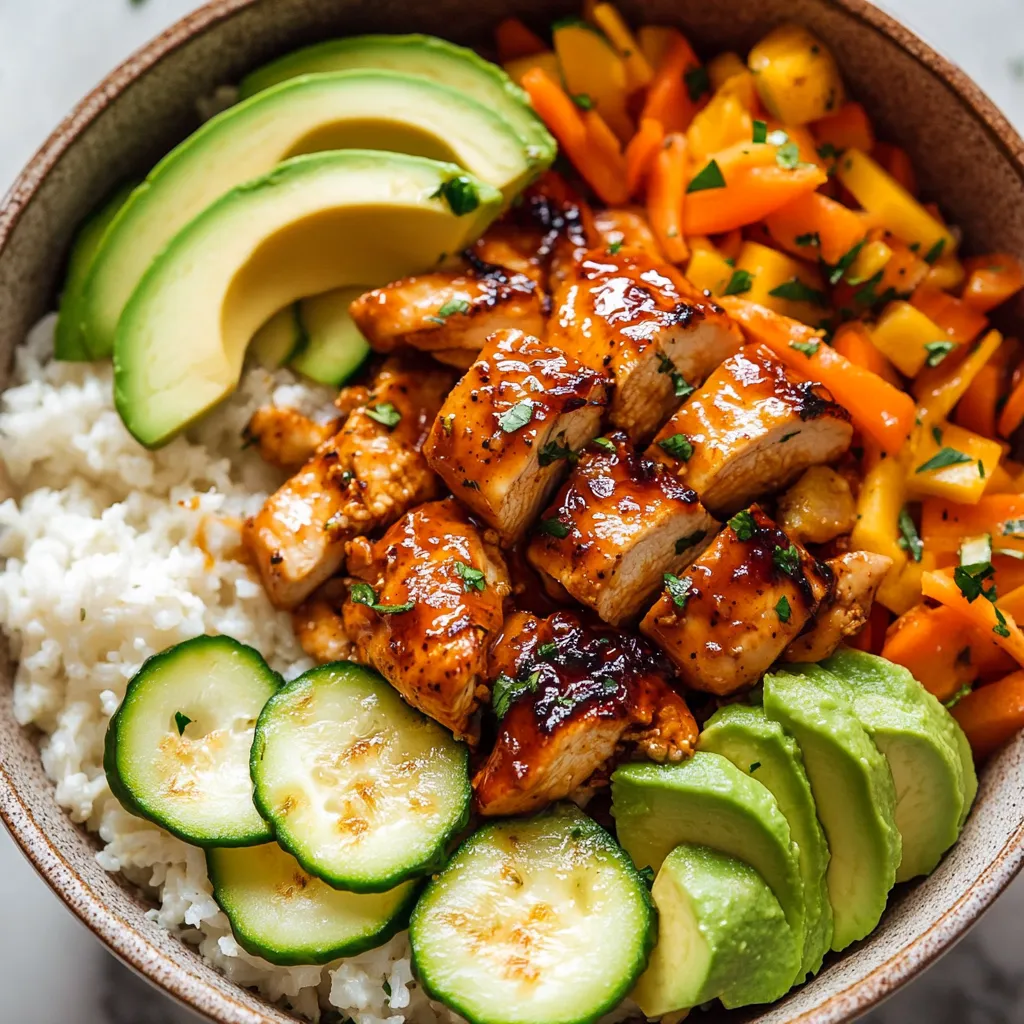 Pin it
Pin it
These one-skillet hot honey chicken bowls pack 37 grams of protein into a perfectly balanced meal that comes together in under 40 minutes. The sweet and spicy hot honey glaze creates an irresistible coating on tender chicken while roasted vegetables add color and nutrition. Perfect for busy weeknights when you want something healthy but exciting, these bowls deliver restaurant-quality flavors using simple ingredients you probably already have in your kitchen.
I developed this recipe during a particularly busy period when I needed something that felt indulgent but was actually nutritious. After countless attempts to perfect the hot honey balance, I discovered that the key lies in building layers of flavor rather than just mixing everything together. My teenage son, who usually lives on pizza and cereal, actually asks for this dish regularly, which feels like a major parenting victory.
Essential Ingredients and Selection Tips
- Boneless chicken breasts: Choose breasts that are similar in thickness for even cooking, or pound thicker pieces to uniform size
- Raw honey: Use pure honey rather than processed versions for better flavor complexity and natural sweetness
- Sriracha sauce: This specific brand provides the perfect balance of heat and tang without overpowering sweetness
- Fresh garlic cloves: Select firm bulbs with tight skin; avoid any with green sprouts or soft spots
- Cayenne pepper: Start with less than you think you need since this adds significant heat that builds over time
- Crushed red pepper flakes: Choose flakes with visible seeds for maximum heat and texture contrast
- Fresh zucchini: Pick smaller, firm zucchini with glossy skin that feels heavy for its size
- Yellow summer squash: Choose squash without blemishes or soft spots that yield slightly to pressure
- Fresh carrots: Select firm, bright orange carrots; pre-shredded carrots work but fresh tastes much better
- Ripe avocados: Look for avocados that yield to gentle pressure but aren't mushy or overly soft
- Cooked rice or quinoa: Use day-old grains if possible as they hold their texture better when reheated
- Fresh lime: Choose limes that feel heavy and have smooth, thin skin for maximum juice content
Detailed Cooking Instructions
- Create the hot honey sauce first:
- In a small bowl, whisk together quarter cup honey, 3 tablespoons sriracha, 2 minced garlic cloves, quarter teaspoon cayenne pepper, and half teaspoon crushed red pepper flakes. Mix thoroughly until completely smooth and set aside. Reserve about 2 tablespoons of this mixture for finishing the dish later.
- Prepare chicken for even cooking:
- Pat chicken breasts completely dry with paper towels, then season both sides generously with salt and pepper. If breasts are particularly thick, pound them to even thickness using a meat mallet or rolling pin. This ensures uniform cooking and prevents dry, overcooked edges.
- Sear chicken to perfection:
- Heat a large oven-safe skillet over medium-high heat. Add a tablespoon of oil and let it shimmer. Place seasoned chicken breasts in the hot skillet and cook for exactly 5 minutes without moving them. This creates a beautiful golden crust that locks in juices. Flip and cook another 5 minutes until second side is golden brown.
- Remove chicken and prepare vegetables:
- Transfer seared chicken to a plate and cover with foil to keep warm. In the same skillet with remaining drippings, add diced zucchini and summer squash. Cook for 3-4 minutes, stirring occasionally, until vegetables just begin to soften but still have some crunch.
- Layer ingredients strategically:
- Remove skillet from heat and add fresh shredded carrots to the cooked squash mixture. Place the seared chicken breasts directly on top of the vegetables. This arrangement allows the chicken juices to flavor the vegetables while preventing them from overcooking.
- Apply sauce and finish in oven:
- Brush the reserved hot honey sauce generously over the chicken breasts, coating completely. Place the entire skillet in a preheated 375-degree oven and bake for 15 minutes until chicken reaches internal temperature of 165 degrees.
- Add final browning:
- Switch oven to broil setting and broil for 3-5 minutes until the honey glaze becomes caramelized and slightly charred. Watch carefully to prevent burning. Remove from oven and let rest for 5 minutes before handling.
- Cube and finish chicken:
- Transfer rested chicken to a cutting board and cube into bite-sized pieces. Toss cubed chicken with the remaining hot honey sauce until every piece is well-coated and glossy.
- Assemble beautiful bowls:
- Start with a base of cooked rice or quinoa in each bowl. Add the roasted vegetable mixture, then top with glazed chicken pieces. Garnish with fresh avocado slices, a squeeze of lime juice, and a drizzle of ranch dressing if desired.
 Pin it
Pin it
The timing of this recipe is crucial for achieving the perfect texture in every component. I learned through trial and error that searing the chicken first creates the best flavor base, while finishing everything together in the oven ensures nothing gets overcooked. The brief broiling step at the end caramelizes the honey glaze into something truly special.
Temperature control makes the difference between good and great hot honey chicken. Using medium-high heat for searing creates that golden crust without burning the honey in the sauce. The moderate oven temperature allows the chicken to cook through gently while the vegetables maintain their texture and vibrant colors.
Sauce distribution technique affects the final flavor dramatically. I brush half the sauce on before baking to create a caramelized coating, then toss the finished chicken with remaining sauce for maximum flavor impact. This double-sauce method ensures every bite has that perfect sweet-spicy balance that makes this dish so addictive.
The vegetable combination provides both nutrition and textural contrast to the rich chicken. Raw shredded carrots add freshness and crunch, while the cooked squash brings sweetness and substance. This mix of textures keeps each bite interesting and prevents the bowl from feeling monotonous.
Meal prep success depends on proper storage techniques. I always keep the avocado and ranch separate until serving time to prevent browning and sogginess. The chicken and vegetables actually taste better after sitting overnight as the flavors continue developing and melding together.
The beauty of this recipe lies in its flexibility without losing the core flavors that make it special. I've made versions with sweet potatoes instead of squash, added pickled vegetables for tang, and even served it over cauliflower rice for lower-carb meals. Each variation maintains that signature hot honey appeal while adapting to different preferences and dietary needs.
This hot honey chicken bowl recipe has become my reliable solution for those nights when I want something that feels special but doesn't require hours of preparation. The combination of protein, vegetables, and complex flavors creates a complete meal that satisfies both nutritional needs and taste cravings. I love knowing that in less than 40 minutes, I can create something that looks and tastes like it came from a trendy restaurant while using ingredients from my regular grocery shopping.
Frequently Asked Questions
- → Can I make this recipe less spicy?
- Yes! Use less sriracha or switch to a milder hot sauce. You can even use tomato sauce for a completely mild version.
- → What can I substitute for the vegetables?
- Try bell peppers, broccoli, snap peas, or any vegetables you have on hand. Just keep the cooking times similar.
- → How long do these bowls keep in the fridge?
- Store them covered in the refrigerator for up to one week. They also freeze well for up to 3 months.
- → Can I use chicken thighs instead of breasts?
- Absolutely! Chicken thighs work great and stay extra juicy. You may need to cook them a few minutes longer.
- → Do I need a cast iron skillet?
- A cast iron skillet works best since it goes from stovetop to oven, but any oven-safe skillet will work fine.
- → Can I prep these bowls ahead of time?
- Yes! Cook everything except the avocado, then store in containers. Add fresh avocado when ready to eat.
